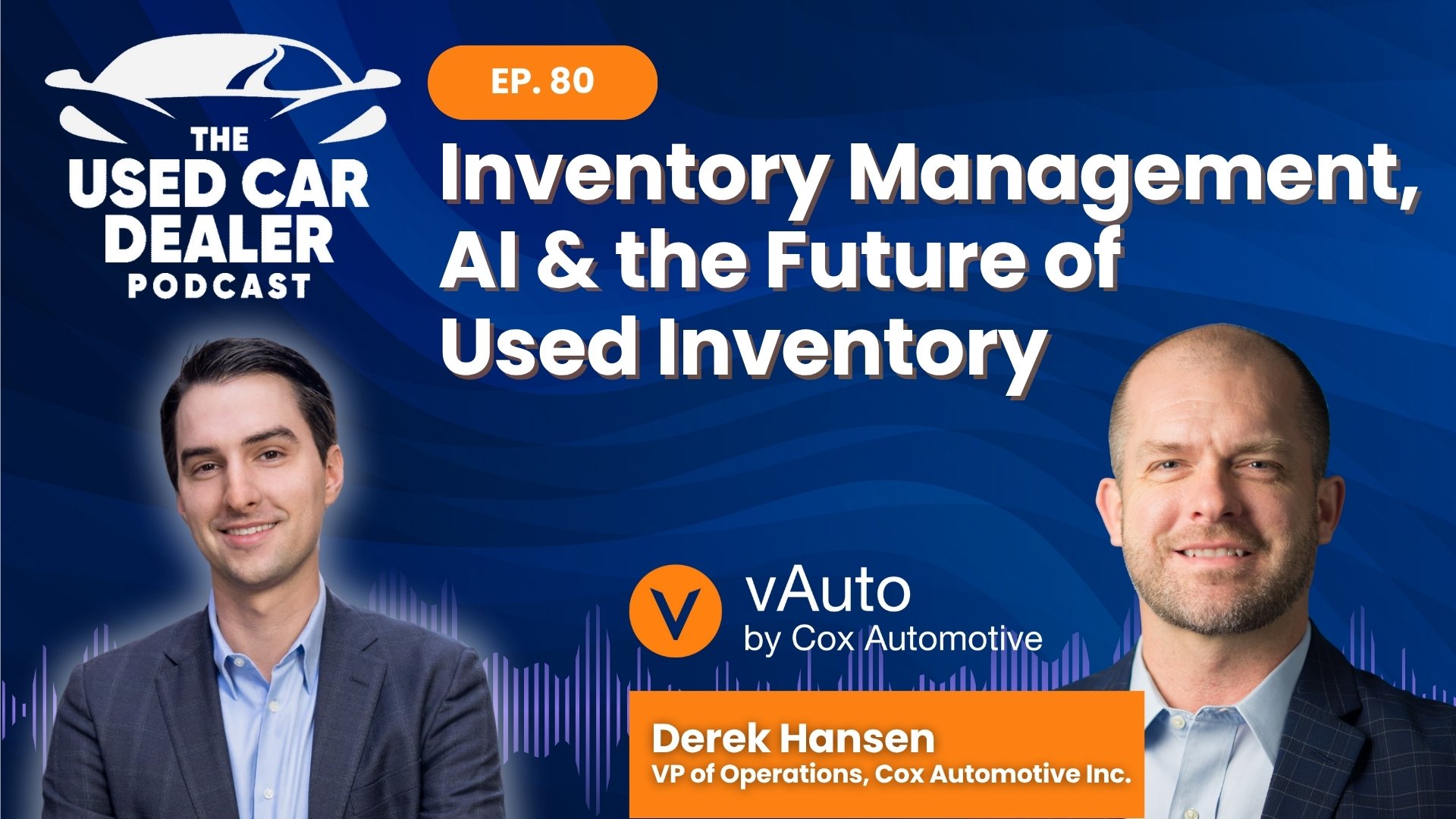In this transcribed episode of the podcast, Zach talks with Randy Kobat, President and CEO of Repair OnDemand, a provider of innovative reconditioning solutions for dealerships. They discuss how reconditioning has become a critical factor in dealership success, the common inefficiencies that slow down the recon process, and how technology can help dealers cut turnaround time and maximize profitability. Randy shares lessons from his extensive background—leading brands like vAuto, Kelley Blue Book Instant Cash Offer, and HomeNet—along with key insights from his decade at Cox Automotive. They also touch on how EVs bring new challenges, such as battery diagnostics, and how a streamlined recon workflow can give dealers a competitive edge.
Zach: Hello, Zach here, and I'm excited to welcome Randy Kobat. He's the president and CEO of Repair OnDemand. Randy brings extensive experience in auto technology—he’s led brands like vAuto, Kelley Blue Book Instant Cash Offer, HomeNet, and DealerTrack DMS during his time at Cox Automotive. Under his leadership, these brands achieved significant growth, including a 5x revenue increase at vAuto. Now at Repair On Demand, Randy is focused on transforming the recon process for dealers and helping them optimize their operations. So, Randy, thanks for joining me on the podcast today.
Randy: Thanks for having me, Zach. I’m glad to be here.
Zach: You’ve had a long career in technology, from leading key brands at Cox Automotive to your current role. Tell us about your journey and how you got into the auto industry.
Randy: My first ten years in the automotive technology space were with what is now CDK Global—at the time, it was ADP Dealer Services. So I started out on the DMS side of automotive technology. My first role was leading strategy for ADP Dealer Services, and I spent eight years there on the automotive side. My last two years with ADP were on the payroll side of the business, and I really missed automotive.
I had a chance to work for some smaller, more entrepreneurial companies like Trilogy and a company called Service Repair Solutions, which had technology for the service side of the business. I really enjoyed my time there and eventually joined vAuto to lead them. I spent almost ten years with Cox Automotive before now joining Repair On Demand.
Zach: What are some of the biggest lessons you learned from scaling brands like vAuto or KBB’s Instant Cash Offer?
Randy: It’s really about focusing on the value you deliver to your customers—truly understanding how your solution delivers value to the dealership. Sometimes we get lost in the feature set, the “blue buttons,” and we forget about how we’re actually helping the dealer improve their business. Staying laser-focused on how you make the dealership better really differentiates you in the marketplace.
Zach: Reconditioning is a crucial but often overlooked part of the dealership process. Why should dealers rethink and streamline how they’re managing it?
Randy: Dealers—both franchise and independent—will retail about 20 million used cars in 2025 and spend roughly 24 billion dollars getting those cars ready to resell. That’s a huge amount of money, yet there’s not a lot of oversight or detailed understanding of the process a car goes through to get retail-ready. It’s a major opportunity area where dealers can save money and shorten the time to market.
Zach: What are some of the biggest inefficiencies you see in dealership reconditioning today?
Randy: One big one is the “choreography” between the internal service department, the used-car department, and the third-party vendors (like PDR, upholstery, wheel repair, detailing). About 20% of the work on a used car at a franchise store happens via these outside vendors, but there isn’t always transparency or coordination. We’re excited to bring more efficiency and effectiveness to that entire process through greater visibility—covering the used-car side, the service side, and the vendor side.
Zach: You touched on this a bit, but preparing a used car for resale requires close coordination between sales, fixed ops, and third-party vendors. Where do you see communication breaking down, and how can dealers fix it?
Randy: Around half of the market still uses spreadsheets or whiteboards for recon. That leaves a lot of room for communication breakdown. Also, any manual process—like writing out paper tickets or waiting a week for the detailer to come—means downtime. Those inefficiencies can be addressed by better scheduling, better parts ordering, and simply having a more streamlined digital workflow.
Zach: What are some of the financial and operational benefits of a more streamlined recon process for both sales and fixed ops?
Randy: Time-to-frontline is even more crucial today than before. Over the last few years, used cars were sometimes appreciating assets. That’s not the case now. Vehicles depreciate quickly, so a 45-day turn is too long. You need closer to 30 days. Shaving days off recon translates directly into less depreciation and better inventory turns, which benefits both sales and fixed ops.
Zach: So how does Repair On Demand help dealers solve recon inefficiencies?
Randy: It starts with the trade-in process. One of our core products is called BlueDriver, an OBD-II diagnostic tool the used-car manager can plug in during the appraisal. There’s a lot you can see by walking around the car—dents, windshield chips, tire depth—but you can’t see the internal mechanical codes or the potential cost of repairs.
By pulling that data in the appraisal, the service department can already know what parts they need, schedule bay time, and get the car retail-ready faster. That diagnostic info flows straight into our reconditioning software, reducing guesswork and delays.
Zach: In your opinion, what are some of the most exciting innovations in recon tech right now?
Randy: I think the proliferation of software platforms to manage recon is huge. Currently, only about half the market uses them, so there’s a big opportunity. But you need a tool that’ll be adopted by the entire operation—used cars, service, and the third-party vendors. Recon is complex because it spans multiple departments and external providers, and you need technology that bridges all of them.
Zach: Any lessons from Cox Automotive about technology that you’ve brought to Repair On Demand?
Randy: A key lesson is making sure dealers have ongoing support to improve their processes over time. We have a customer success team and performance managers who ensure our clients get the most out of the solution. It’s not just about selling software—it’s about continuing to help dealers operate more efficiently and effectively.
Zach: Shifting gears to industry trends: with the rise of EVs, are there new challenges in recon, such as battery diagnostics or specialized repairs?
Randy: For sure. Tesla is the most prevalent EV in the used market, but it doesn’t have a standard OBD-II port for battery data. We’re working on technologies to gather battery-health data from the plug-in port. For other EV brands with OBD-II compatibility, we can capture that info. The resale value of an EV hinge on remaining battery life, so providing that data is increasingly important in trade-in and recon.
Zach: Looking ahead, what’s next for Repair On Demand, and what trends or opportunities are you most excited about in the next 12 to 24 months?
Randy: One major initiative is building out our vendor network. Right now, we have about 16,000 technicians using our software to help with reconditioning at dealerships across the country. By linking them into our reconditioning platform, we’ll make it a genuine two-sided market where dealers and vendors can collaborate in one system.
We’ll be able to give dealers performance feedback on those third-party vendors and recommend alternatives if a current vendor isn’t measuring up. That data-driven approach will help everyone in the recon process operate more effectively.
Zach: This is really interesting, and I’ve learned a lot just talking to you, Randy, about the recon process. Thanks for coming on the podcast and sharing your insights. If someone wants to reach out to you, what’s the best way to do so?
Randy: I’m always available via email at randy.kobach@repairondemand.com.
Zach:Awesome. Well, thanks again, Randy, for joining me on the podcast today.
Randy: Thanks, Zach. I appreciate it.

.jpg)




.jpg)
.jpg)
.jpg)
.jpg)


.jpg)
.png)
.png)
